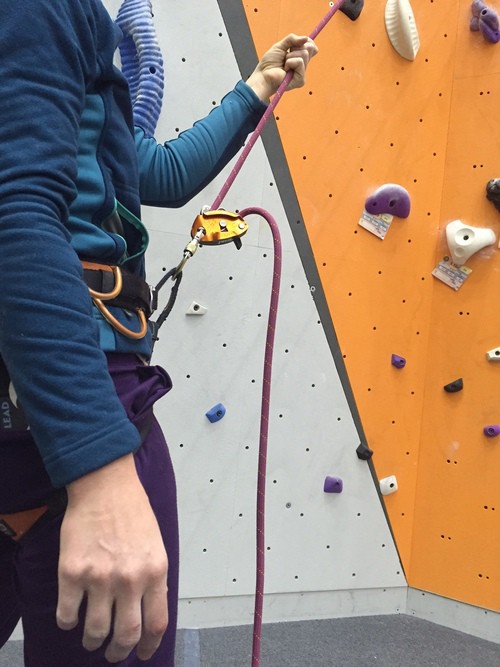The importance of a good belay can’t be overstated. The severity of a bad belay could come with grave consequences.
 SO HERE’S WHAT YOU NEVER DO (in the pic)… PUT THAT BRAKE HAND BACK ON THE ROPE!!!
SO HERE’S WHAT YOU NEVER DO (in the pic)… PUT THAT BRAKE HAND BACK ON THE ROPE!!!At First Ascent, we want everyone to give a good belay. We have a Learning the Ropes classthat teaches proper knot tying and belay technique when top-roping, and our Learning to Lead class gives climbers who want to climb “on the sharp end” the nuanced skill set to climb, fall and belay with confidence. Even after those classes, visitors and members who would like to belay have to test their skills (and pass the test) to become certified.
At times, even the longest tenured belayers can get comfortable and complacent, which leads to bad habits. Habits like opening the hand holding the brake-end of the rope; not using the non-brake-hand to secure the rope between the belay device and the brake hand to negotiate the excess slack; and keeping the brake hand above the belay device for an extended period of time. All of these things could place a climber in a compromising position or create a situation where equipment fails.
The thing about belay devices and “safety” equipment is that they are NOT fool-proof. No matter what device you are using, it’s crucial to remember that although these devices have features to arrest falls by using friction and simple mechanics, they should be considered assisted braking devices and NOT safety devices.
Climbing is dangerous, and a climber is only as safe as the quality of their equipment, their attention to detail, and the trust they place in their belayer. A belayer unsure of themselves should ask questions and practice prior to having someone on the other end of their rope. A distracted belayer is as bad as one who doesn’t know what they’re doing. Belayers must stay focused: no talking, no watching other climbers, no activity that would otherwise take attention off the climber. A belayer oblivious or ignorant to their poor technique should be corrected.
Luckily, most of the time when First Ascent staff walk the sport climbing area, we see good belay technique. We are not shy, however, if we see questionable technique or practices. We are also not shy about stopping a belay check if a person does not exhibit proper technique. And we won’t be shy about telling someone who has already passed a belay check that they cannot continue to belay until the get re-checked if they consistently use unsafe technique.
It’s not that we want to say “gotcha!” We want to keep everyone safe, and we encourage you not to be shy when you see a friend or neighbor using poor belay technique. After all, this is a community, and we’re only as strong as our weakest link.
Belay skills are just that: skills. It takes time to learn and sometimes in the process of doing something over and over again, important things are unlearned. While no one will ever be perfect, practice can help get us close. We will continue to be vigilant to help ensure the safety of all and are always happy to help coach technique or advise on good belay technique. Let us know if you need any belay beta!
xoxo #letsclimbchicago
Text: Gabriel Skvor Images: Andrew St. John
